
CURATOR’s EYE
Autumn in Japan with Art
Follow TRiCERA on Instagram and check out our creative artists
5%OFF & free shipping 1st purchase
FIRSTART5
10%OFF 2nd purchase after 1st purchase!
Welcome to TRiCERA
Hi there! We are pleased to have you here 🎉
Could you please describe yourself?
Guest
The latter half of the period that is classified as Modern Art, Post-ImpressionismCubism Symbolism and Symbolism emerged.
Post-Impressionism was represented by painters such as Van Gogh and Gauguin, who used the unique expressive power of color itself.
Van Gogh and Gauguin, in particular, influenced later artistic movements such as Fauvism, Expressionism, Abstract Art, and Primitivism.
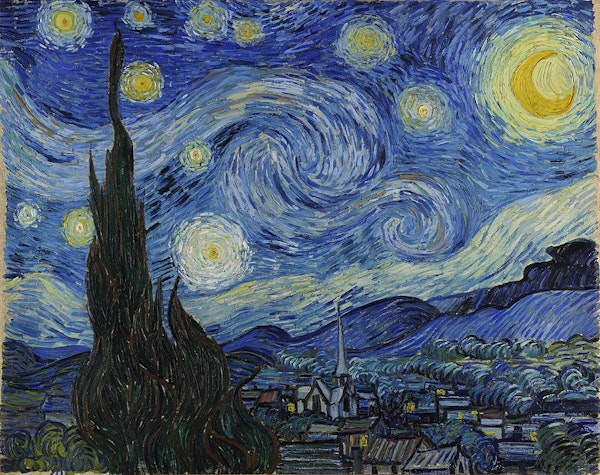
Vincent van Gogh, "Starry Moonlit Night," 1889, Museum of Modern Art (MoMA), New York
Early 20th century, Henri Matisse Georges Braque, André Derain, Raoul Dufy, and others revolutionized the art world in Paris.
They were known as Fauvisme (Fauvism), who saw color as an autonomous expressive force in itself. In particular, they considered color important for expressing the inner feelings and sensations of human beings and studied the autonomous world created by color itself.
%2C_Museum_of_Modern_Art.jpg?w=600&h=398)
Henri Matisse, "Dance (I)," 1909, Museum of Modern Art (MoMA), New York
Henri Matisse's "Dance (I)" is a particularly important work both for Matisse's own artistic career and for the development of modern painting.
This work is said to reflect the artistic impulse of early mankind latent in primitive art.
In the painting, warm colors are used for the human figures in contrast to the cold blue-green background, and naked women are dancing rhythmically, holding hands in a circle. It seems to convey a sense of freedom of feeling and hedonism, unbound by anything specific.
The third trend is cubism.
Cubism, in art historical terms, emphasizes intellectual composition and form over sensuous and shifting impressions Paul Cézanne s theory of expression.
Cézanne's influence is strong in the work of Pablo Picasso Pablo Picasso. Picasso saw natural forms as an accumulation of cubes, spheres, and cones, and by piling them up, he "composed" rather than "reproduced" his subjects. Cubism Cubism invented painting.
In 1907, he created the painting Daughters of Avignonfrom 1907 is one of the most representative works of cubism. It was a radical revolution in the tradition of Western painting, introducing primitive art techniques and a flat spatial composition unrestrained by conventional perspective.

Paul Cézanne, "Mount Saint-Victoire" (1904), Musée d'Orsay
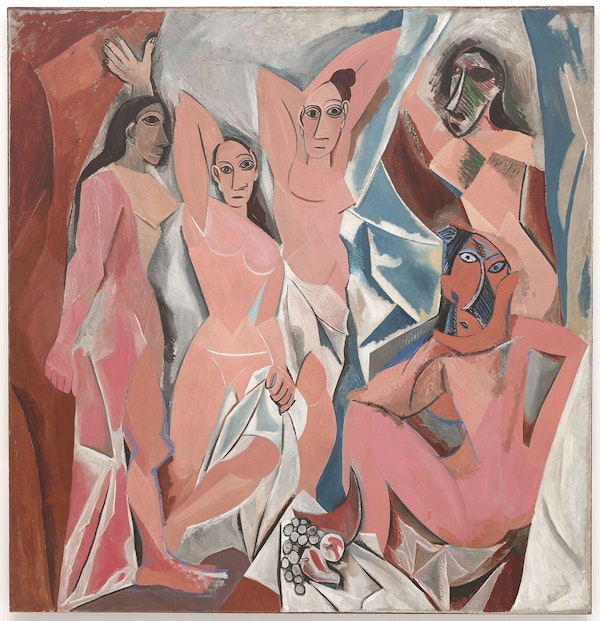
Pablo Picasso, Daughters of Avignon, 1907, Museum of Modern Art (MoMA), New York
Symbolism was born in the 19th century as a reaction against realism, which pursued the visible world, and impressionism, which was an extension of realism, Symbolism Symbolism was born in the 19th century as a reaction against Van Gogh.
Symbolism is an art style that emerged almost in parallel with the late Impressionism of Van Gogh, Gauguin, Cézanne, and others.
Symbolist painters, in reaction to Impressionism, tended to emphasize intellectual composition and form rather than sensuous and shifting impressions of their own internal world.
Symbolism is found throughout Europe, as well as in the United States and Russia, Gustave Moreau and Odilon Redon and the British Pre-Raphaelites , by Gustav Klimt , by Arnold Becklin and Edvard Munch and Edvard Munch.
In terms of influences on later generations, symbolism was particularly strong in the work of Vasily Kandinsky and Piet Mondrian and Russian avant-garde (art movement) Surrealism Surrealism(art movement).
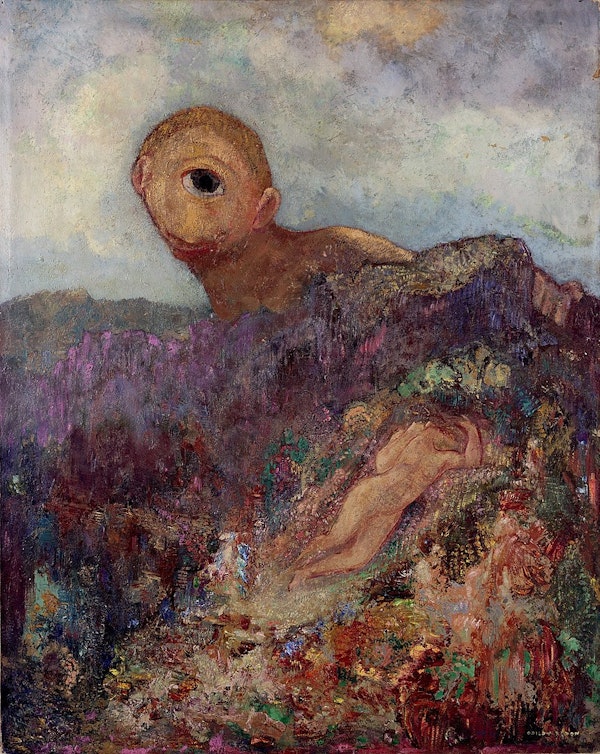
Odilon Redon, "Cyclops" (1898 - 1914), a representative work of Symbolism
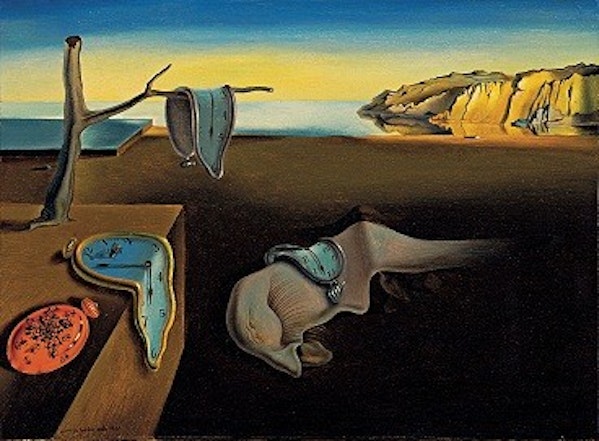
Representative of Surrealism, Salvador Dalí, "The Fixation of Memory," 1931, Museum of Modern Art (MoMA), New York
In addition to the above-mentioned art movements, there are also "primitivism" and "naive art.
The naive school was created by artists who had no formal art education, and their works are characterized by their simplicity and originality due to their self-taught nature.
The Sunday painter Henri Rousseau is a representative artist.
In most cases, the Naive Art artists were self-taught in technique and composition, and created their works for personal enjoyment while earning a living from other occupations.
Thus, although not precisely defined as an art movement, this spontaneous (as categorized by art historians in later periods rather than by the artist's intentions) trend is distinguished for convenience by the term "nihilism" as opposed to "nouveau riche.
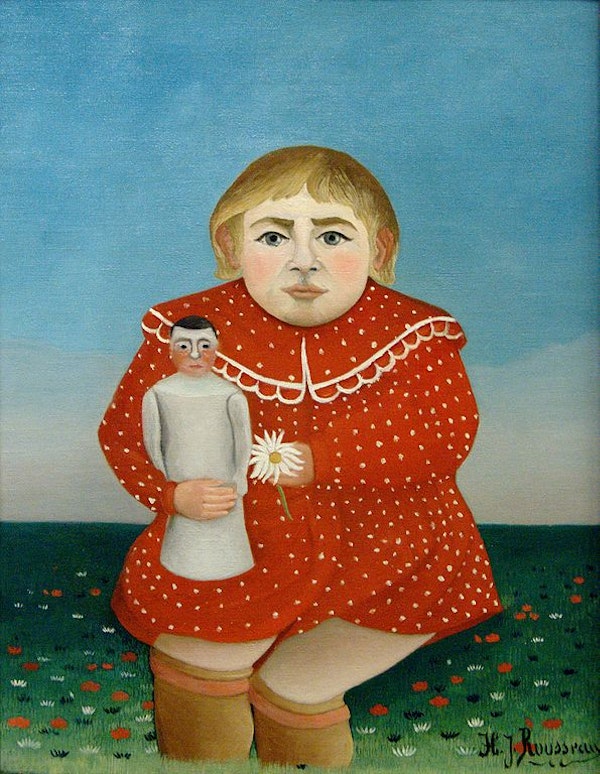
Henri Rousseau, "Child with a Doll," 1908
Let us take a look back at the artistic movements that shaped modern art.
The first half of Modern Art:
Romanticism, Realism, Impressionism
Second half of Modern Art:
Post-Impressionism, Cubism, Fauvism, Symbolism, Rusticism
These led to the art movements of later generations. Although opinions differ even among experts, Impressionism became the source of Abstract Expressionism, and Post-Impressionism, as well as the Vienna Secession and Art Nouveau, which are not introduced here, were mixed and passed on to German Expressionism, and other artistic movements were created and disappeared repeatedly. Although no single artistic movement remains unabated for centuries due to the limited lives of artists, it continues to influence contemporary artists, critics, and art historians through its discovery or, conversely, its permeation to the extent that it goes unnoticed.
A distinction is made between modern and contemporary art. However, in terms of the magnitude of the influence of modern art, it may be said that in a sense, modern art has continued to the present day in the 21st century. As mentioned briefly at the beginning of this article, let us take a closer look at how "modern" art was created with reference to the pre-modern era.
The birth of modern art can be traced back to the Industrial Revolution that occurred between the 18th and 19th centuries, when major technological innovations in production and transportation in Western Europe and North America revolutionized economic, social, and cultural structures.
During this period, a new form of transportation, the steam engine, changed the way people lived and worked. It gave birth to travel, which facilitated international travel, especially in land-locked Europe, expanding the world of the common man and speeding up economic, cultural, and ideological exchanges. As urban centers prospered, workers flocked to the cities for industrial-intensive enterprises, and the urban population grew rapidly. While capitalism became highly developed through scientific and technological advances and the Industrial Revolution, it also led to a decline in faith, and it can be said that the social authority of Christianity gradually weakened and became increasingly secularized.

Opening of the Stockton and Darlington Railroad, 1825
Changes in the expression of Western art are also closely linked to these social changes. In parallel with the physical mobility promoted by the railroads mentioned above, there was a shift toward individualism in the fine arts, and a shift from traditional values that regarded classical ideal beauty as an absolute norm to modern values that relativize beauty as subjective.
In his article "On the Varieties of Beauty" (1857), the Romantic painter Delacroix argued that beauty is not found only in ancient Greece, but that different times and regions have different beauties, and that great poets and artists create beauty because of their individuality and singularity. This shift in the definition of beauty is a fundamental departure from the pre-modern view of art.
In the 21st century, the contemporary art market, influenced by popular culture, continues to be a fundamental part of what is known as the contemporary art and art world, and the fundamental understanding of relative aesthetic values continues to be held.
It should not be overlooked that the change in art values in terms of the reception of works of art has also occurred: since the end of the 19th century, the grading of aesthetic values has shifted from the traditional "academic" to the "critical" system. For the sake of this commentary, let us review the formation of modern individualism once and for all.
Prior to the modern era, artists generally produced works of art on order from wealthy private patrons and churches. Most of these works of art were in a genre called historical painting, which depicted biblical or mythological scenes and taught the viewer their content.
In the modern era, with the development of capitalism and the middle class, middle-class citizens, rather than royalty, aristocrats, and religious powers, began to become the new receptive audience for paintings. This change in audience had a profound effect on the artworks themselves, and instead of historical, portrait, and religious paintings, there was a dramatic increase in the production of easy-to-understand and accessible landscapes and genre paintings.
As a result, success within academia became less absolute on the part of artists. Courbet, Manet, and the Impressionist painters distanced themselves from the French academic system and succeeded in gaining acceptance, especially among the American middle class via art dealers. The "critical system" that emerged in the late 19th century was a new framework for the acceptance of painting, and it continues to function robustly in today's art world.
Kahnweiler (Daniel Henry Kahnweiler, 1884 - 1979), a prominent Cubist art dealer, who worked with Pablo Picasso and Georges Braque, is considered a pioneer of the gallerist system in contemporary art and created a new art market system.
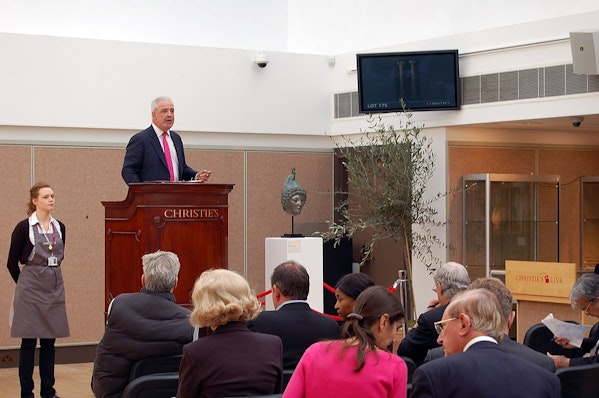
The Crosby Garrett Helmet on auction at Christie's, London, on 7 October 2010.
The 19th century was also characterized by the development of popular arts such as printmaking, decorative arts, and graphic design, as opposed to the fine arts of painting, sculpture, and architecture, Lautrec Lautrec Alphonse Mucha and Alphonse Mucha.
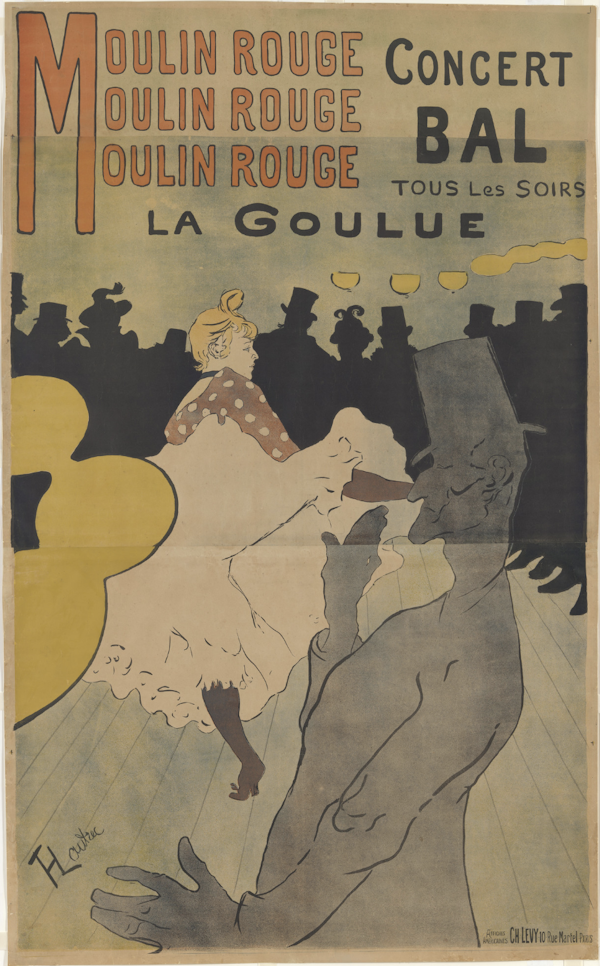
Henri de Toulouse-Lautrec , Moulin Rouge, La Goulue, 1891
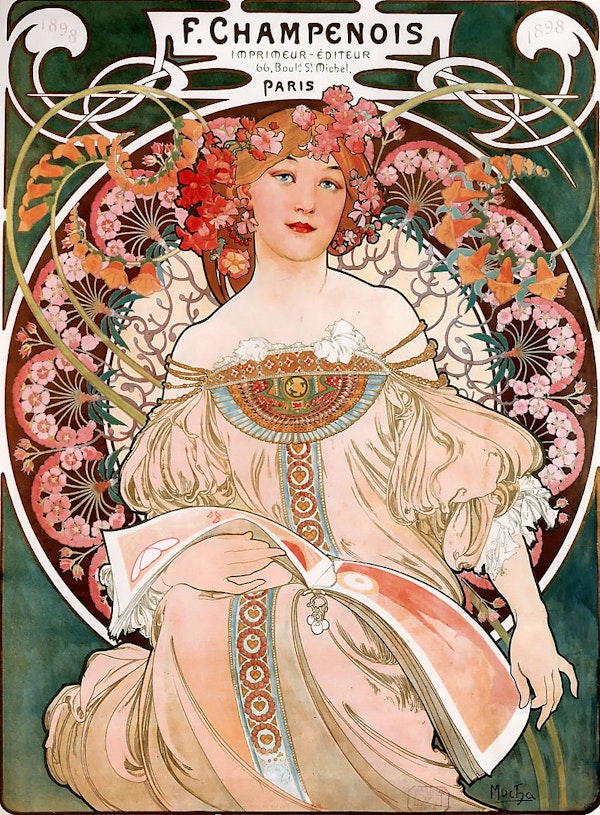
Alphonse Mucha F. Champenois Imprimeur-Éditeur, 1897, Lithograph
As the middle class developed, wallpaper, furniture, book illustrations and bindings, stained glass, tapestries, mosaics, and the ceramics industry flourished, and highly artistic decorative arts, which deviated from mere decoration, spread throughout Europe. The Pre-Raphaelites and William Morris's Arts and Crafts movement are representative examples; Art Nouveau, which became popular at the end of the 19th century, is the pinnacle of the 19th century decorative arts movement.
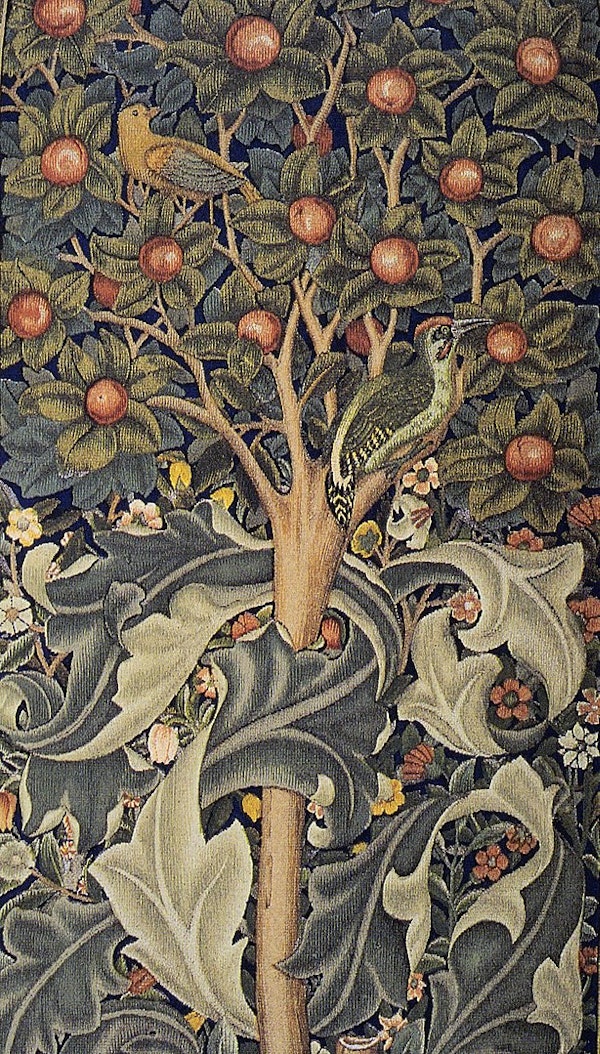
William Morris tapestry, 1885
The rise of popular art in the 19th century is mirrored today in the 21st century, when street art using mediums such as spray art, stickers, stencils, and sign tampering on city walls is beginning to be marketed in the same way as fine art.
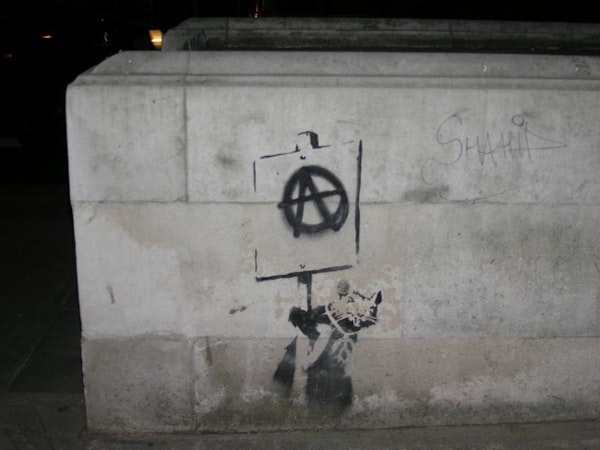
Banksy Anarchist Rat, Taken by Shermozle
A new medium has emerged that can be considered the artistic equivalent of painting.
The most prominent example is photography, which, after the invention of the daguerreotype, the earliest photographic method, in 1839, gained the ability to depict realistic images in an improved manner, threatening the status of realistic painting.
This necessitated that painters find a different method of expression than photography, and impressionism and romanticism, which reproduced what the artist subjectively felt rather than reproducing reality as it was, developed.
On the other hand, photography, on the other hand Alfred Stieglitz and others began to move away from reproducing reality as it is, and began to strive to become "art" like painting.
The advent of the moving image (1859) also had a major impact on painting. It can be said that the invention of the moving image made narrative representation in painting less important and motivated artists to pursue characteristics unique to painting.
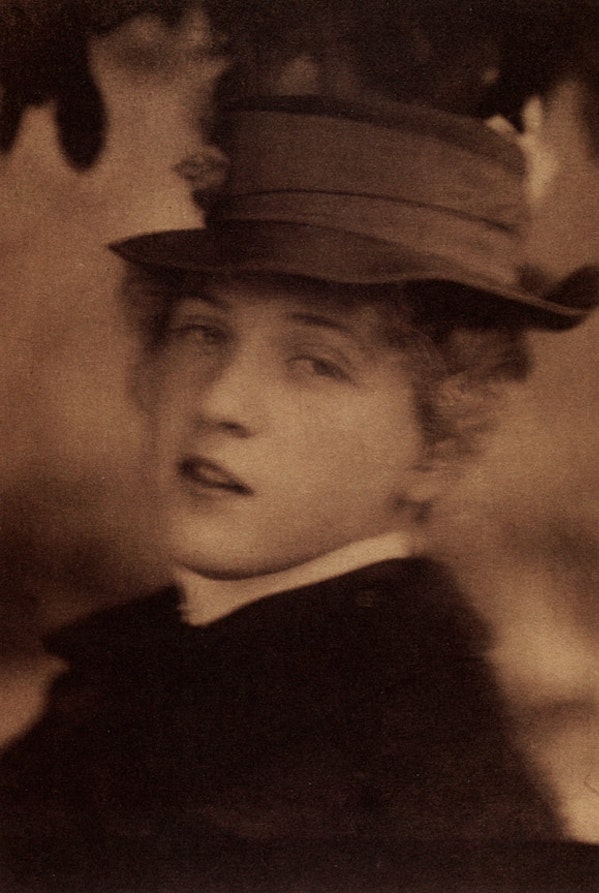
Alfred Stieglitz, Miss S.R., 1905.
It is no exaggeration to say that the 19th century was the era of the World's Fairs.
This issue is closely tied to the growing colonization of the Western powers in the 19th century. As Western powers expanded their territorial ambitions around the world, the distance between the West and the outside world quickly shortened, resulting in the importation of a wide variety of culture and art into Europe.
Thus were born the World Expositions. In particular, the Paris Expositions, held five times between 1855 and 1900, had a great influence on artists. Incidentally, it was not until 1867, when Japan officially participated in the Paris Expositions for the first time, that Japonisme began to permeate Western art in earnest.
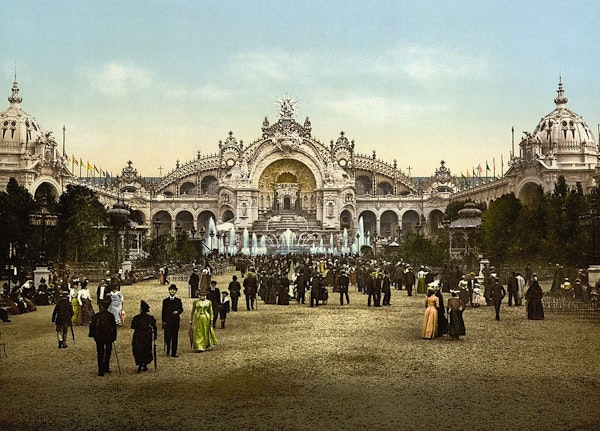
Paris Exposition of 1900
Today's Outsider Art is in the lineage of the Rustic School and Primitivism that were popular at the beginning of the 20th century. Art historians tend to hesitate to contextualize the artists in this category because they are unique and have no awareness that they are working within the "outsider art" movement, but their originality and innovation deserve mention. Also, Henry Darger and others, are often the subject of interesting psychoanalytic studies developed in the 20th century, as most of these artists have mental illnesses or serious social incompatibilities.
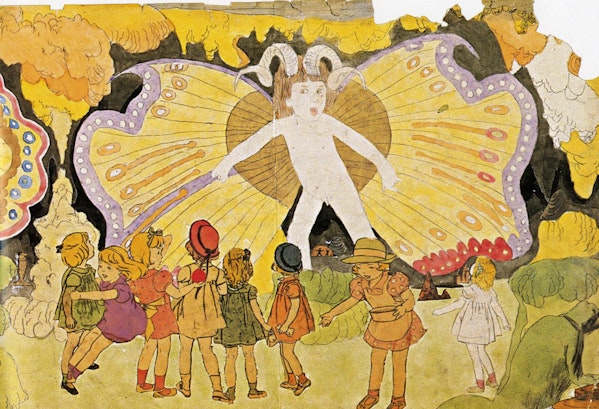
Henry Darger|In the Realms of the Unreal
Activities that are imbued with social and political messages and aggression, Vandalism and Artivism and "artivism".
Experts are divided on whether or not these activities are included in the category of art. Vandalism of Art, in particular, refers to vandalism, graffiti, and defacement of works of art.
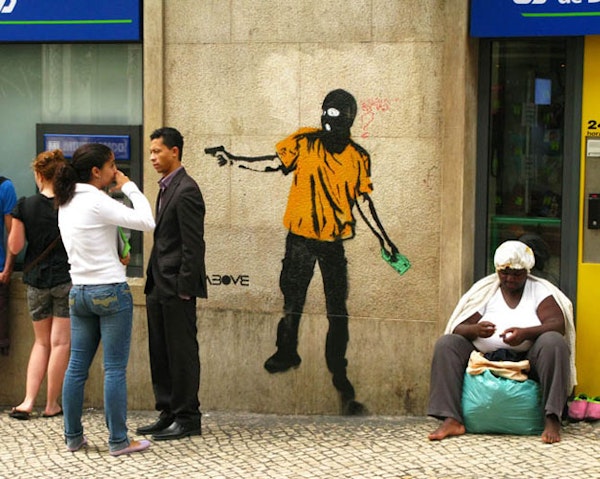
Giving to the Poor, a stencil by American street artist Above addressing the issue of homelessness. Lisbon, Portugal, 2008. By Hdepot - Own work, CC BY-SA 3 .0
Kant once said, "Modernism criticizes from within," and what may come with the advance of Vandalism and Artivism may be "the self-destruction of modern art by modern art. Such self-destruction may emerge in a different form due to the amplification of economic disparities associated with capitalist society and ideological struggles involving environmental issues. In this case, it may not necessarily be modern art itself that is being destroyed, but individuals who claim that other problems are being exacerbated by its influence. -In 2022, environmental activists are simultaneously performing in museums around the world by throwing tomato cans at historically famous paintings.
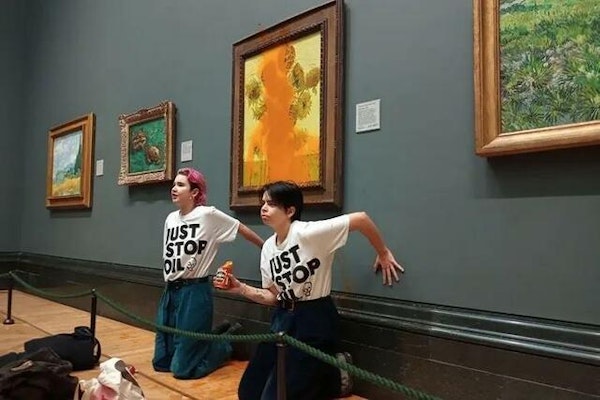
Environmental activists throwing tomato soup at Van Gogh's "Sunflowers" at the National Gallery, London, October 2022
See TRiCERA ART's latest works
TRiCERA ART members receive a variety of benefits and preferences.
- Discounts, including members-only secret sales and coupons
- Create your own collection by registering your favorite artists
- Receive updates on popular artists, exhibitions, and events
- Receive a weekly newsletter with selected art
- Personal Assessment to find out what kind of art you like.
Please register as a member for free and receive the latest information.

Writer
TRiCERA ART
The latter half of the period that is classified as Modern Art, Post-ImpressionismCubism Symbolism and Symbolism emerged.
Post-Impressionism was represented by painters such as Van Gogh and Gauguin, who used the unique expressive power of color itself.
Van Gogh and Gauguin, in particular, influenced later artistic movements such as Fauvism, Expressionism, Abstract Art, and Primitivism.

Vincent van Gogh, "Starry Moonlit Night," 1889, Museum of Modern Art (MoMA), New York
Early 20th century, Henri Matisse Georges Braque, André Derain, Raoul Dufy, and others revolutionized the art world in Paris.
They were known as Fauvisme (Fauvism), who saw color as an autonomous expressive force in itself. In particular, they considered color important for expressing the inner feelings and sensations of human beings and studied the autonomous world created by color itself.
%2C_Museum_of_Modern_Art.jpg?w=600&h=398)
Henri Matisse, "Dance (I)," 1909, Museum of Modern Art (MoMA), New York
Henri Matisse's "Dance (I)" is a particularly important work both for Matisse's own artistic career and for the development of modern painting.
This work is said to reflect the artistic impulse of early mankind latent in primitive art.
In the painting, warm colors are used for the human figures in contrast to the cold blue-green background, and naked women are dancing rhythmically, holding hands in a circle. It seems to convey a sense of freedom of feeling and hedonism, unbound by anything specific.
The third trend is cubism.
Cubism, in art historical terms, emphasizes intellectual composition and form over sensuous and shifting impressions Paul Cézanne s theory of expression.
Cézanne's influence is strong in the work of Pablo Picasso Pablo Picasso. Picasso saw natural forms as an accumulation of cubes, spheres, and cones, and by piling them up, he "composed" rather than "reproduced" his subjects. Cubism Cubism invented painting.
In 1907, he created the painting Daughters of Avignonfrom 1907 is one of the most representative works of cubism. It was a radical revolution in the tradition of Western painting, introducing primitive art techniques and a flat spatial composition unrestrained by conventional perspective.

Paul Cézanne, "Mount Saint-Victoire" (1904), Musée d'Orsay

Pablo Picasso, Daughters of Avignon, 1907, Museum of Modern Art (MoMA), New York
Symbolism was born in the 19th century as a reaction against realism, which pursued the visible world, and impressionism, which was an extension of realism, Symbolism Symbolism was born in the 19th century as a reaction against Van Gogh.
Symbolism is an art style that emerged almost in parallel with the late Impressionism of Van Gogh, Gauguin, Cézanne, and others.
Symbolist painters, in reaction to Impressionism, tended to emphasize intellectual composition and form rather than sensuous and shifting impressions of their own internal world.
Symbolism is found throughout Europe, as well as in the United States and Russia, Gustave Moreau and Odilon Redon and the British Pre-Raphaelites , by Gustav Klimt , by Arnold Becklin and Edvard Munch and Edvard Munch.
In terms of influences on later generations, symbolism was particularly strong in the work of Vasily Kandinsky and Piet Mondrian and Russian avant-garde (art movement) Surrealism Surrealism(art movement).

Odilon Redon, "Cyclops" (1898 - 1914), a representative work of Symbolism

Representative of Surrealism, Salvador Dalí, "The Fixation of Memory," 1931, Museum of Modern Art (MoMA), New York
In addition to the above-mentioned art movements, there are also "primitivism" and "naive art.
The naive school was created by artists who had no formal art education, and their works are characterized by their simplicity and originality due to their self-taught nature.
The Sunday painter Henri Rousseau is a representative artist.
In most cases, the Naive Art artists were self-taught in technique and composition, and created their works for personal enjoyment while earning a living from other occupations.
Thus, although not precisely defined as an art movement, this spontaneous (as categorized by art historians in later periods rather than by the artist's intentions) trend is distinguished for convenience by the term "nihilism" as opposed to "nouveau riche.

Henri Rousseau, "Child with a Doll," 1908
Let us take a look back at the artistic movements that shaped modern art.
The first half of Modern Art:
Romanticism, Realism, Impressionism
Second half of Modern Art:
Post-Impressionism, Cubism, Fauvism, Symbolism, Rusticism
These led to the art movements of later generations. Although opinions differ even among experts, Impressionism became the source of Abstract Expressionism, and Post-Impressionism, as well as the Vienna Secession and Art Nouveau, which are not introduced here, were mixed and passed on to German Expressionism, and other artistic movements were created and disappeared repeatedly. Although no single artistic movement remains unabated for centuries due to the limited lives of artists, it continues to influence contemporary artists, critics, and art historians through its discovery or, conversely, its permeation to the extent that it goes unnoticed.
A distinction is made between modern and contemporary art. However, in terms of the magnitude of the influence of modern art, it may be said that in a sense, modern art has continued to the present day in the 21st century. As mentioned briefly at the beginning of this article, let us take a closer look at how "modern" art was created with reference to the pre-modern era.
The birth of modern art can be traced back to the Industrial Revolution that occurred between the 18th and 19th centuries, when major technological innovations in production and transportation in Western Europe and North America revolutionized economic, social, and cultural structures.
During this period, a new form of transportation, the steam engine, changed the way people lived and worked. It gave birth to travel, which facilitated international travel, especially in land-locked Europe, expanding the world of the common man and speeding up economic, cultural, and ideological exchanges. As urban centers prospered, workers flocked to the cities for industrial-intensive enterprises, and the urban population grew rapidly. While capitalism became highly developed through scientific and technological advances and the Industrial Revolution, it also led to a decline in faith, and it can be said that the social authority of Christianity gradually weakened and became increasingly secularized.

Opening of the Stockton and Darlington Railroad, 1825
Changes in the expression of Western art are also closely linked to these social changes. In parallel with the physical mobility promoted by the railroads mentioned above, there was a shift toward individualism in the fine arts, and a shift from traditional values that regarded classical ideal beauty as an absolute norm to modern values that relativize beauty as subjective.
In his article "On the Varieties of Beauty" (1857), the Romantic painter Delacroix argued that beauty is not found only in ancient Greece, but that different times and regions have different beauties, and that great poets and artists create beauty because of their individuality and singularity. This shift in the definition of beauty is a fundamental departure from the pre-modern view of art.
In the 21st century, the contemporary art market, influenced by popular culture, continues to be a fundamental part of what is known as the contemporary art and art world, and the fundamental understanding of relative aesthetic values continues to be held.
It should not be overlooked that the change in art values in terms of the reception of works of art has also occurred: since the end of the 19th century, the grading of aesthetic values has shifted from the traditional "academic" to the "critical" system. For the sake of this commentary, let us review the formation of modern individualism once and for all.
Prior to the modern era, artists generally produced works of art on order from wealthy private patrons and churches. Most of these works of art were in a genre called historical painting, which depicted biblical or mythological scenes and taught the viewer their content.
In the modern era, with the development of capitalism and the middle class, middle-class citizens, rather than royalty, aristocrats, and religious powers, began to become the new receptive audience for paintings. This change in audience had a profound effect on the artworks themselves, and instead of historical, portrait, and religious paintings, there was a dramatic increase in the production of easy-to-understand and accessible landscapes and genre paintings.
As a result, success within academia became less absolute on the part of artists. Courbet, Manet, and the Impressionist painters distanced themselves from the French academic system and succeeded in gaining acceptance, especially among the American middle class via art dealers. The "critical system" that emerged in the late 19th century was a new framework for the acceptance of painting, and it continues to function robustly in today's art world.
Kahnweiler (Daniel Henry Kahnweiler, 1884 - 1979), a prominent Cubist art dealer, who worked with Pablo Picasso and Georges Braque, is considered a pioneer of the gallerist system in contemporary art and created a new art market system.

The Crosby Garrett Helmet on auction at Christie's, London, on 7 October 2010.
The 19th century was also characterized by the development of popular arts such as printmaking, decorative arts, and graphic design, as opposed to the fine arts of painting, sculpture, and architecture, Lautrec Lautrec Alphonse Mucha and Alphonse Mucha.

Henri de Toulouse-Lautrec , Moulin Rouge, La Goulue, 1891

Alphonse Mucha F. Champenois Imprimeur-Éditeur, 1897, Lithograph
As the middle class developed, wallpaper, furniture, book illustrations and bindings, stained glass, tapestries, mosaics, and the ceramics industry flourished, and highly artistic decorative arts, which deviated from mere decoration, spread throughout Europe. The Pre-Raphaelites and William Morris's Arts and Crafts movement are representative examples; Art Nouveau, which became popular at the end of the 19th century, is the pinnacle of the 19th century decorative arts movement.

William Morris tapestry, 1885
The rise of popular art in the 19th century is mirrored today in the 21st century, when street art using mediums such as spray art, stickers, stencils, and sign tampering on city walls is beginning to be marketed in the same way as fine art.

Banksy Anarchist Rat, Taken by Shermozle
A new medium has emerged that can be considered the artistic equivalent of painting.
The most prominent example is photography, which, after the invention of the daguerreotype, the earliest photographic method, in 1839, gained the ability to depict realistic images in an improved manner, threatening the status of realistic painting.
This necessitated that painters find a different method of expression than photography, and impressionism and romanticism, which reproduced what the artist subjectively felt rather than reproducing reality as it was, developed.
On the other hand, photography, on the other hand Alfred Stieglitz and others began to move away from reproducing reality as it is, and began to strive to become "art" like painting.
The advent of the moving image (1859) also had a major impact on painting. It can be said that the invention of the moving image made narrative representation in painting less important and motivated artists to pursue characteristics unique to painting.

Alfred Stieglitz, Miss S.R., 1905.
It is no exaggeration to say that the 19th century was the era of the World's Fairs.
This issue is closely tied to the growing colonization of the Western powers in the 19th century. As Western powers expanded their territorial ambitions around the world, the distance between the West and the outside world quickly shortened, resulting in the importation of a wide variety of culture and art into Europe.
Thus were born the World Expositions. In particular, the Paris Expositions, held five times between 1855 and 1900, had a great influence on artists. Incidentally, it was not until 1867, when Japan officially participated in the Paris Expositions for the first time, that Japonisme began to permeate Western art in earnest.

Paris Exposition of 1900
Today's Outsider Art is in the lineage of the Rustic School and Primitivism that were popular at the beginning of the 20th century. Art historians tend to hesitate to contextualize the artists in this category because they are unique and have no awareness that they are working within the "outsider art" movement, but their originality and innovation deserve mention. Also, Henry Darger and others, are often the subject of interesting psychoanalytic studies developed in the 20th century, as most of these artists have mental illnesses or serious social incompatibilities.

Henry Darger|In the Realms of the Unreal
Activities that are imbued with social and political messages and aggression, Vandalism and Artivism and "artivism".
Experts are divided on whether or not these activities are included in the category of art. Vandalism of Art, in particular, refers to vandalism, graffiti, and defacement of works of art.

Giving to the Poor, a stencil by American street artist Above addressing the issue of homelessness. Lisbon, Portugal, 2008. By Hdepot - Own work, CC BY-SA 3 .0
Kant once said, "Modernism criticizes from within," and what may come with the advance of Vandalism and Artivism may be "the self-destruction of modern art by modern art. Such self-destruction may emerge in a different form due to the amplification of economic disparities associated with capitalist society and ideological struggles involving environmental issues. In this case, it may not necessarily be modern art itself that is being destroyed, but individuals who claim that other problems are being exacerbated by its influence. -In 2022, environmental activists are simultaneously performing in museums around the world by throwing tomato cans at historically famous paintings.

Environmental activists throwing tomato soup at Van Gogh's "Sunflowers" at the National Gallery, London, October 2022
See TRiCERA ART's latest works
TRiCERA ART members receive a variety of benefits and preferences.
- Discounts, including members-only secret sales and coupons
- Create your own collection by registering your favorite artists
- Receive updates on popular artists, exhibitions, and events
- Receive a weekly newsletter with selected art
- Personal Assessment to find out what kind of art you like.
Please register as a member for free and receive the latest information.

Writer
TRiCERA ART